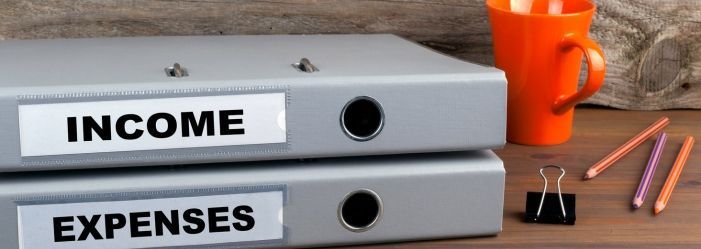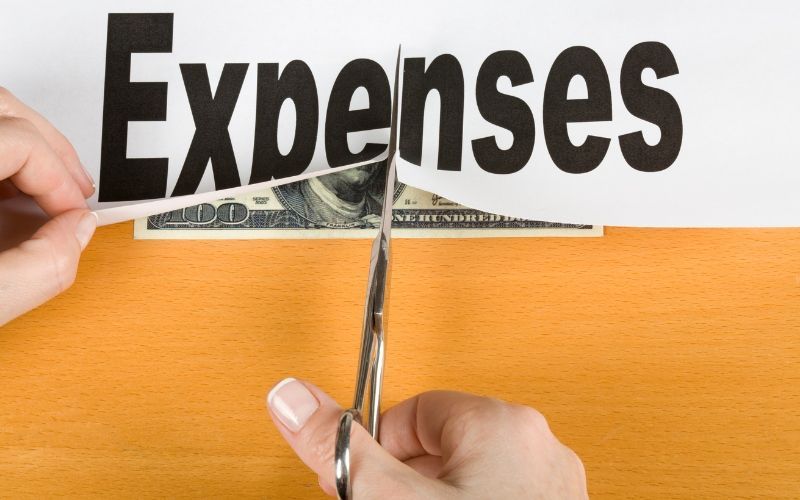Tracking and Trimming Forgettable Costs Can Help You

American household debt recently hit $16.9 trillion according to the Federal Reserve. Credit card debt balances alone average over $6,000 per U.S household. An average personal loan debt stands at well over $10,000. This rising consumer debt load reflects years of overspending our income and digging a deep financial hole.
Often this overspending happens gradually in the form of recurring monthly payments for small daily expenses that don't seem significant. That $5 cup of coffee, the $10 takeout lunch, the $15 monthly streaming subscription we don’t use. These small expenses we take for granted without realizing the true costs over time.
Cutting out just a single car monthly mortgage payment, and $5 daily car insurance expense could save over $1,800 per year. Invested over the long run for retirement, that may amount to around $250,000.
The little insignificant purchases we mindlessly gloss over and even justify can massively hamper our ability to save money pay off debt faster or reach other important money goals.
This guide will walk through key strategies to identify these small expenses and reduce their endless drain on our wallet. We’ll establish spending rules and habits to reclaim thousands wasted every year and redirect those savings into what matters most — eliminating debt, establishing an emergency fund, planning for retirement and more. Tiny adjustments today that transform futures financial situations.
Understanding How Small Expenses Add Up
It's easy to overlook small daily expenses. That quick cup of coffee on the way to work, the snacks at the office vending machine, the utility bills, the monthly streaming service subscription we barely use. These minor monthly costs can really add up without us even realizing it.
Let's take a seemingly small daily expense as an example - stopping at Starbucks for a $5 latte on the way to work. $5 doesn't seem like much on its own. But when we look at that cost over an entire year, it paints a different picture.
- Buying a $5 latte 300 days a year (taking some time off work) costs $1,500 annually
- Invested over 10 years at a 7% return, that's nearly $20,000 wasted
- Invested over 30 years for retirement, it could amount to around $140,000
The tiny spending of cash each day is easy to justify and ignore. Yet multiplied over weeks, months, and years, it becomes a massive drain on our finances. Money that could have been put to much better use paying off debt, cutting spending, or even saving money for the future.
This example applies to any small but recurring expense we mindlessly gloss over. The $10 monthly streaming service we never watch. The $15 self-storage unit holding stuff we should just donate. The $100 gym membership we never use. They can all waste thousands of dollars that could enrich our lives in bigger ways.
How to Identify Wasted Spending on Small Expenses
The first step is awareness - recognizing all those little expenses that bleed our wallets dry over time. To do this, we need to track where exactly our money is going each month.
This can be done by:
- Recording daily purchases in a notebook or spreadsheet
- Using budgeting software or money management apps
- Downloading bank and credit card statements to categorize spending
This spending tracking over the course of a full month will highlight exactly where our money flows day to day, week to week. The daily bagel, the drive-through soda on a road trip, the Prime subscription we forgot about. It seems trivial on its own, but tallied up it makes a visible impact.
Armed with this spending detail, we can then identify categories where small expenses are wasting money that could be better used elsewhere. We might spot $100/month on convenience store snacks, $30/week eating lunch out, $500 last year from forgotten monthly memberships.
Seeing it all added up over a month and especially over a full year is often an eye-opening "a-ha" moment. We can finally recognize those small leaks that are sinking our financial ship, even if slowly. Just from that perspective shift, many people immediately cut back on expensive spending habits.
Now that we better understand the impact of small expenses on our food budget over time, let's look at how to actually cut costs and reduce this wasted spending.
Creating a Plan to Save money
Once we've tracked our spending and identified areas where small costs are wasting money, the next step is creating a plan to reduce these expenses.
Review Recent Spending to Flag Unnecessary Purchases
Go back through your spending, tracking spending, from the last 1-2 months. Make a list of all your biggest expenses and the small, recurring expenses that seem unnecessary or not a priority.
- Daily cafe purchases
- Vending machine snacks at work
- Frequent convenience store runs
- Unused streaming service subscriptions
- Unused gym memberships
- Expensive morning coffee habits
- Regular pizza delivery charges
- Any other subscription charges no longer needed
Be brutally honest with yourself here - is this purchase providing enough value to justify the recurring expense? If not, it goes on the cut list.
Cancel Unused Monthly Subscriptions
Go through that canceled list and take action. Call the gym to cancel the membership. Go online and cancel any unused streaming or box subscription services. Removing monthly expenses provides immediate savings quickly.
If you use a subscription management tool like Truebill, you can handle all these cancellations in one place to save more money and time.
Restrict Extra Spending
Some small expenses can't be outright canceled, but we can set spending rules to restrict them. Daily cafe visits or frequent convenience store runs fall into this expense category too. Consider setting a firm limit for yourself on these types of discretionary expenses.
For example own coffee, you might set a rule of only visiting a coffee shop twice a week and limiting yourself to $20 per week on convenience store runs. Use an envelope or create a budgeting system where you take out set cash at the start of the week for these purposes. When it's gone, it's gone.
Cut Down on Other Ways Small Costs to Save Money
Identify other areas where small costs trickle in that you may have spotted in your tracking:
- Bring your lunch to work - Eating out less can save $100+ per month
- Restrict online impulse shopping - Unsubscribe from promotional emails, stay off browsers
- Use public transportation - Take the bus instead of paying for gas multiple times per week
Every area of overspending likely has options to further reduce spending in the small leaks. The key is being creative and coming up with rules you can stick to long term.
Make an Actionable Budget with Reduced Spending
The final piece takes your list of reduced expenses and hardened rules cut spending, and puts them into a monthly budget. Review your income, subtract essential fixed costs, and then allocate reduced spending freeze or levels cut spending to your discretionary spending categories.
Having this all laid out in detail in a zero-based budget makes your reduced spending plan tangible. You can track and adjust it monthly and turn it into lasting behavior change.
Start Tracking Your Spending Habits
Before making any changes to cut expenses, first, you need visibility into exactly where your money is currently going. Tracking your full spending is crucial to identify areas of waste and overspending.
How to Track Your Expenses
1. Manual Tracking
Manually recording daily purchases is the most low-tech but foolproof tracking approach. Carry a small notebook and write down every expense right as it happens - your morning coffee, picking up lunch, stopping at the gas station. The benefit is it makes us extremely aware of all spending in real-time.
2. Expense Tracking Apps
Money management apps like Mint, PocketGuard, and You Need a Budget (YNAB) can automatically track most expenses by syncing to bank/credit card accounts. Any cash expenses need to be input manually. A major perk is robust categorization and trends over time.
3. Download Account Statements
For a manual high-level snapshot, you can download monthly payment statements from checking accounts, your credit card debt, cards, and investment accounts and categorize everything line-by-line into spending buckets like groceries, dining out, shopping, bills, etc.
What to Track
Be sure to capture every single outflow of money, no matter how small it seems. The $2 pack of gum, the $3 song download, the $5 Starbucks. Tiny incidentals we don't remember add up substantially. Part of the tracking awareness makes you second guess these little impulse purchases more.
How Long to Track Spending
Experts recommend tracking expenses closely for at least 1 month to spot spending habits. 3-6 months of tracking gives even clearer insight into trends over time - like holiday spikes and lower monthly payments for shopping apps example. But in as little as one week patterns often vividly emerge.
Once you track spending, you can use the data to inform budget changes and identify wasteful small expenses prime for reduction. Then we can course correct towards more mindful saving and spending.
Saving and Using Money from Small Expense Cuts
The best part of reducing wasted spending on small expenses is that we now have extra money freed up every month. But it's critical we use this money intentionally rather than letting it trickle away again on miscellaneous stuff.
Put Money Saved Into High Yield Savings
When we reduce expenses in areas like cutting out a daily Cafe trip, no car payments, limiting convenience store runs, or canceling an unused streaming service, we want to directly funnel that saved money into savings before we can spend it elsewhere.
Online high-yield savings accounts now offer over 4% APY interest rates in late 2022 - a great place to store money saved from expense cuts. By directly transferring the $100 per month you managed to save on reduced small expenses into these savings accounts, it keeps the money working for you rather than disappearing.
This also ensures we save money rather than just spending it elsewhere. And money in dedicated savings or investment accounts tends to be more protected against temptation spending compared to spending money in everyday checking accounts.
Use Extra Cash to Pay Off Debt
Another great use of money saved specifically from small expense cuts is paying down interest rates and off debt faster. Loans like credit cards and personal loans can quickly snowball, so the debt payments and interest rates on any extra monthly payments have an outsized impact.
Here’s a simple scenario. If your reduced daily Cafe trips saved $100 per month, putting that directly toward credit card debt with 18% APR instead will eliminate that balance of $670 faster!
The key is to automate transfers of money saved on reduced expenses directly into paying off debts like credit cards each month before that money can get spent elsewhere. This small change in monthly payment amount can shave years of expensive interest payments off and accelerate becoming debt-free.
Reach Financial Goals Quickly
Beyond debt payoff, cutting small expenses so you have more cash freed up each month can greatly accelerate big financial goals like saving for a home down payment, retirement, college funds, or that dream vacation.
For example, reducing your daily coffee shop run from $30 per week to $10 per week saves $80 per month. Investing that $80 per month toward retirement over 25 years could accumulate over $55,000 (assuming a conservative 5% annual return)!
The small minute-by-minute choices we make to save rather than overspend truly do compound substantially over months and years. Keeping this big-picture perspective makes it easier and more motivating to make those small daily expense cuts that can transform our financial futures for the better.
Keeping a Long-Term Perspective
Changing daily habits to reduce expenses requires diligence and dedication. We have to remain focused on the bigger picture rewards down the road rather than immediate gratification in the present moment.
Continue Tracking Expenses
Periodically reviewing expenses needs to become an ingrained habit. Set calendar reminders every 3-6 months to spend a week tracking daily spending. Or use a tracking app like PocketGuard that has automatic recurring payments, and provides ongoing visibility cutting expenses.
Catching any areas where small expenses might be creeping back up gives you the opportunity to reassess needs and reign back in wasteful spending. Maintaining this vigilance is key to preventing backsliding.
Avoid Reverting to Old Habits
Humans are creatures of habit, so it's easy to fall back into behaviors like stopping daily at Starbucks or ordering takeout multiple times per week out of routine. When you cut an overspent area from your expenses, actively think about what new routine will take its place.
Bringing your lunch could be swapped in to replace a daily cafe visit. Having snacks and cold water stocked at home prevents convenience store runs. Meal prepping over the weekends makes grabbing takeout less tempting. Deliberately establishing alternative habits makes expense-cutting more sustainable.
Find New Areas for Savings
As time passes we may get accustomed to our previously reduced cost of living. But new opportunities to cut expenses will often crop up for an extra percent or two of savings. Keep finding small ways to keep energy costs and trim more expenses to amplify savings month after month.
For example:
- Renegotiating cell phone and internet bills
- Turning down the thermostat an extra couple of degrees
- Securing cheaper auto insurance when policies renew
- Asking for fee waivers on bank accounts or credit cards
Small incremental changes add up substantially. A few percentage points here and there redirects more money into important priorities over the years. A 1% shift today compounds to so much more down the road.
The time and effort invested to consciously cut small expenses pays enormous dividends in the long run. What seems insignificant at the moment expands tremendously when consistently saved and set aside for years on end. Keeping this long-term view makes the small daily choices easier and more rewarding.
Shop with a List
Grocery shopping likely makes up a significant portion of your monthly spend. Heading to the supermarket without a plan makes it all too fun and an easy way to overspend on items you don’t need. Shopping with a list is a simple but powerful way to curb impulse purchases and cut grocery costs.
Create Detailed Grocery Lists
Before each shopping trip, take inventory of what you currently have and create a detailed list organized by category of what you need to buy.
You can use notes on your phone, an app like AnyList, or good old pen and paper. Easy organization helps efficiency once you’re in the store.
Planning out recipes for future meals for the week? Add all necessary ingredients to ensure you don’t forget anything necessary for the meal plan. Evaluating needs for packed work lunches? Itemize what you require to avoid expensive cafeteria purchases.
Leave blank spaces between categories to keep additions separate and legible. Apps may also suggest items you buy regularly but forgot to add.
Stick Firmly to Your List
Now comes the hard part - exercising self-control to avoid tossing in random items not on your essentials list! Wandering aisles aimlessly makes impulse buys all too easy. Have tunnel vision - walk directly between the sections that contain your list items without even glancing at other temptations. Grab what you wrote down then head straight to checkout.
If stores conveniently place candy and magazines by registers to encourage last-minute additions, avert your eyes and focus only on paying and getting out of there. Sticking firmly to well-planned lists takes some practice, but prevents money leakage. Give yourself a small allowance for anything extra if needed, but try to rely on lists to curb spontaneous purchase
FAQs
Conclusion
As we've seen, small daily expenses that seem trivial at the moment can add up to thousands of dollars wasted every year. But with some diligence to identify these money leaks and conscious effort to plug them shut, we can significantly bolster our financial situation.
Redirecting those small forgettable latte purchases or impulse convenience store runs into paying off credit card balances or a retirement fund makes a world of difference. Compound and interest rates, paired with the power of time work wonders when consistent.
The small minute-by-minute choices we barely think about today truly do expand tremendously in the long run future. Keep this incredible potential scale in mind when faced with temptation spending. Your future self with thank you immensely down the road!
If you are struggling with overwhelming debt and want to explore your debt relief options, Pacific Debt Relief offers a free consultation to assess your financial situation. Our debt specialists can provide objective guidance relevant information and support to help find the right debt relief solution.
✔ Accredited by Better Business Bureau with BBB A+ rating (4.93 rating and 1678 reviews)
✔ US News and World Reports and Bankrate ranked Pacific Debt Relief as one of “The Best Debt Relief Companies of 2024”
✔ 6.9 star rating by BestCompany.com (over 2379 client reviews)
✔ 4.8 star rating by TrustPilot based (over 1613 verified consumer reviews)
✔ ConsumerAffairs.com Accredited (over 544 verified reviews with an average rating of 5 stars)
✔ A Top 10 Rated Compan by TopTenReviews.com , ConsumersAdvocate.com and Top10debtconsolidation.com
✔ 4.6 star rating by Google (229 client reviews)
✔ 100% rating by SuperMoney (9 client reviews)
Reduce Your Credit Card Debt By Up to Half

BBB Reviews | 4.9/5.0 Rating









 Do Not Sell My Personal Information
Do Not Sell My Personal Information